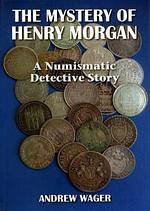
PREV ARTICLE
NEXT ARTICLE
FULL ISSUE
PREV FULL ISSUE
BOOK REVIEW: THE MYSTERY OF HENRY MORGAN: A NUMISMATIC DETECTIVE STORYOver the past few weeks I've been reading The Mystery of Henry Morgan: A Numismatic Detective Story by Andrew Wager. As Jim Duncan noted in an earlier review,
Andrew Wager is an active numismatic researcher specializing in tokens of the U.K. His book is doubly interesting for numismatic researchers because in addition to describing what he learned about Morgan and his tokens in his research, Wager details his research step-by-step, taking the reader along for the ride on a difficult, interesting and rewarding journey. As noted in other E-Sylum book reviews (such as Fred Holabird's Coins of the Comstock, it is a painstaking task under ordinary conditions to compile information about long-ago token issuers from historical records such as city directories, municipal records, newspapers and the like. But Wager's task was complicated by the common name of his subject. There are thousands of Morgans and dozens of Henrys to be found in the records, and sorting them out two centuries later is no simple task. This, coupled with the fact that "Henry Morgan" is also the name of a famous pirate led earlier researchers to speculate that the name was the nom de plume hiding the true identity of the token maker. The first seven chapters detail Wager's review of the earlier published research on Morgan, and his independent searches through historical archives in search of the true Henry Morgan. Pictured in the book are several of Morgan's tokens, Photos of buildings at the addresses where Morgan lived or conducted business, and original source documents including parish register marriage and birth records, an 1808 letter to Boulton and Watt, and an 1843 almanack advertising a venereal disease cure (yes, there is a connection!). Much of Wager's research focuses on the family of Frederick Dietrichsen, a London tailor who operated businesses at the address listed on Morgan's newspaper advertisements, 12 Rathbone Place. I think the book would benefit from the addition of a family tree diagram to make it easier to follow who's who. A reader who takes in the book at one sitting may not require it, but as one who had to read it in multiple sittings having a diagram would have been helpful. Wager's review of insurance company records luckily led to a clue. However, without an index the task was going to be a lengthy one, and I was davised by the librarian, with a certain lack of confidence in her voice, that "I might be lucky". After a long trip to the Guildhall Library in London and two hours into a laborious trawl through the original registers I was beginning to think my quest was a waste of time. Then, serendipity! While what Wager learned from the records was important, but not conclusive. Another clue came in the form of a letter from Mr. Morgan himself. It came from a perhaps not-so-surprising source for modern researchers - eBay! Chapter nine illustrates and discusses the implications of the previously unknown August 1811 printed form letter. I won't spoil the fun by revealing the author's conclusion. I certainly recommend the book to collectors of U.K. tokens and to numismatic researchers in general, of which there are many in the E-Sylum readership ranks. Wager rightly notes that there are many tools available to researchers today that were unavailable to authors of the past.
We have to remember that nowadays it is much easier to make the kind of connections that I have been able to in researching this book. The most important of these was identifying the name of Frederick's wife, Sarah, and I was able to do this thanks to the work of the Church of Latter Day Saints in creating the International Genealogical Index and placing it on the Internet. William Boyne, William Davis and Captain Warren, the three main nineteenth century cataloguers of the series did not have the benefits of such modern technology. Below are links to two earlier E-Sylum articles about the book. In the second, author Andrew Wager offers a discount for E-Sylum readers. To read earlier E-Sylum articles, see: MORE ON THE MYSTERY OF HENRY MORGAN: A NUMISMATIC DETECTIVE STORY (www.coinbooks.org/esylum_v12n07a07.html)
MORE ON HENRY MORGAN: A NUMISMATIC DETECTIVE STORY
(www.coinbooks.org/esylum_v12n27a08.html)
The Numismatic Bibliomania Society is a non-profit organization promoting numismatic literature. See our web site at coinbooks.org. To submit items for publication in The E-Sylum, write to the Editor at this address: whomren@gmail.com To subscribe go to: https://my.binhost.com/lists/listinfo/esylum All Rights Reserved. NBS Home Page Contact the NBS webmaster 
|
